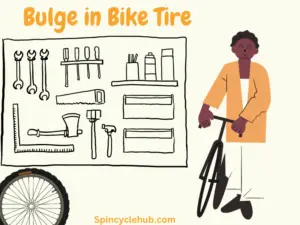Introduction
Picture this: you’re cruising along on your bike, feeling the wind in your hair and enjoying the freedom of the open road. But suddenly, you notice a strange bulge on your tire. What does it mean? Is it just a minor inconvenience, or is it something more serious? In this article, we’ll dive into the world of bike tires and explore the causes and implications of a bulge in your tire. So hold on tight, folks, because we’re about to take a bumpy ride!
Understanding Bike Tires
Before we tackle the issue of bulges, let’s start with the basics. Bike tires come in different sizes, treads, and materials, depending on the type of bike and the terrain you’re riding on. They play a crucial role in providing traction, absorbing shock, and maintaining stability while you’re on the move.
What Causes a Bulge in a Bike Tire?
Now, let’s get to the heart of the matter. A bulge in a bike tire can be caused by various factors. One common culprit is improper tire inflation. If you overinflate your tire or underinflate it, the excess pressure can cause the tire to bulge outward. Another possible cause is a manufacturing defect, where a weak spot in the tire’s structure leads to a bulge over time.
Is a Bulge Dangerous?
You might be wondering, “Is this bulge something I should be worried about?” Well, it depends. A small bulge may not pose an immediate danger, but it’s still worth investigating. However, if the bulge is large or continues to grow, it could be a sign of a more serious issue. Riding on a tire with a significant bulge increases the risk of a blowout, which can result in loss of control and accidents.
Inspecting and Addressing the Bulge
If you notice a bulge in your bike tire, it’s essential to take action promptly. Here’s what you can do:
Stop and Examine the Bulge
First and foremost, find a safe spot to stop and inspect the bulge. Check for any visible signs of damage or punctures that may have caused the bulge.
Measure the Bulge
Using a ruler or tape measure, measure the size of the bulge. This information will be helpful in determining the severity of the issue and whether it’s safe to continue riding.
Release Some Pressure
If the tire is overinflated, releasing some pressure might help alleviate the bulge. But be careful not to release too much, as an underinflated tire can also be problematic.
Consult a Professional
When in doubt, it’s best to seek professional help. Take your bike to a local bike shop or consult a mechanic who can assess the situation and provide expert advice.
Preventing Tire Bulges
They say prevention is better than cure, and that holds true for bike tire bulges too. Here are some tips to help you avoid encountering this issue in the first place:
Maintain Proper Tire Pressure
Regularly check your tire pressure and ensure it’s within the recommended range. Use a reliable pressure gauge to avoid overinflation or underinflation.
Inspect Your Tires Regularly
Make it a habit to inspect your tires for any signs of wear and tear. Look for bulges, cuts, or punctures that may need immediate attention.
Avoid Rough Terrain
If possible, try to avoid riding on rough terrain or surfaces that can put excessive stress on your tires. Opt for smoother roads or paths whenever feasible.

Conclusion
A bulge in your bike tire is not something to be taken lightly. While small bulges may not pose an immediate threat, it’s crucial to address the issue promptly to ensure your safety on the road. Regular tire maintenance, proper inflation, and periodic inspections are key to preventing bulges and other tire-related problems. Remember, when it comes to bike tires, a little TLC can go a long way.
FAQs (Frequently Asked Questions)
1. Can I still ride my bike with a small bulge in the tire?
While it’s not recommended, you can ride your bike cautiously with a small bulge. However, it’s advisable to have it inspected and repaired as soon as possible.
2. How do I know if my tire is properly inflated?
Refer to the recommended tire pressure indicated on the sidewall of your tire or consult your bike’s user manual. Use a pressure gauge to measure the pressure and adjust accordingly.
3. Can I fix a tire bulge myself?
Minor bulges caused by overinflation may be temporarily fixed by releasing some pressure. However, it’s best to have a professional examine the tire to determine the underlying cause and provide appropriate solutions.
4. What should I do if I experience a tire blowout while riding?
If you experience a tire blowout, try to remain calm and steer the bike to a safe stopping place. Avoid sudden braking or jerky movements. Once stopped, assess the situation and seek assistance if needed.
5. How often should I inspect my bike tires?
Regularly inspect your bike tires at least once a month or before each ride. Look for signs of bulges, cuts, punctures, or excessive wear. Replace tires that show significant damage or are past their recommended lifespan.
Watch this one,
Video Credits – Brad Beaird
DOWNLOAD THIS ARTICLE : Bulge in Bike Tire
You May Also Like
- Bike Tire Valve Stem Pushed In: What to Do?
- U Brake to V Brake Adapter: Simplifying Your Brake Upgrade
- 60 vs 120 TPI: Unraveling the Thread Count Mystery



